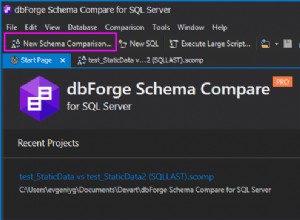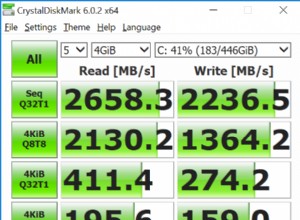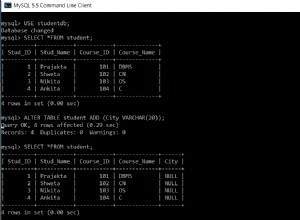sebbene ciò non sia possibile con sql%rowcount, è possibile se si scrive il codice trigger, ma ciò significa che è necessario un trigger su tutte le tabelle che si desidera monitorare. Inoltre, i trigger rallenteranno un po' le operazioni.
es.:
SQL> select * from one;
ID
----------
1
2
SQL> select * from child_of_one;
ID O_ID
---------- ----------
1 1
2 1
3 1
4 2
5 2
6 2
7 2
8 2
vogliamo che una specifica del pacchetto contenga un array di tabelle + conteggi:
SQL> create or replace package foo
2 as
3 type rowcount_tab is table of pls_integer index by varchar2(30);
4 t_rowcount rowcount_tab;
5 end foo;
6 /
Package created.
vogliamo un trigger nella tabella di livello superiore per azzerare questi conteggi:
SQL> create or replace trigger one_biud
2 before insert or update or delete
3 on one
4 declare
5 begin
6 foo.t_rowcount.delete;
7 end;
8 /
Trigger created.
questo presuppone che tu sia interessato solo all'array con un'eliminazione dalla tabella di livello superiore. in caso contrario, vorresti un attivatore su ogni tabella con foo.t_rowcount.delete('TABLE_NAME') invece.
ora un dopo per ogni riga si attiva su ogni tabella di interesse per impostare gli array:
SQL> create or replace trigger one_aiudfer
2 after insert or update or delete
3 on one
4 for each row
5 declare
6 begin
7 if (foo.t_rowcount.exists('ONE'))
8 then
9 foo.t_rowcount('ONE') := nvl(foo.t_rowcount('ONE'), 0)+1;
10 else
11 foo.t_rowcount('ONE') := 1;
12 end if;
13 end;
14 /
Trigger created.
SQL> create or replace trigger child_of_one_aiudfer
2 after insert or update or delete
3 on child_of_one
4 for each row
5 declare
6 begin
7 if (foo.t_rowcount.exists('CHILD_OF_ONE'))
8 then
9 foo.t_rowcount('CHILD_OF_ONE') := nvl(foo.t_rowcount('CHILD_OF_ONE'), 0)+1;
10 else
11 foo.t_rowcount('CHILD_OF_ONE') := 1;
12 end if;
13 end;
14 /
Trigger created.
ora quando cancelliamo o qualsiasi altra cosa:
SQL> delete from one where id = 1;
1 row deleted.
SQL> declare
2 v_table varchar2(30);
3 begin
4 v_table := foo.t_rowcount.first;
5 loop
6 exit when v_table is null;
7 dbms_output.put_line(v_table || ' ' || foo.t_rowcount(v_table) || ' rows');
8 v_table := foo.t_rowcount.next(v_table);
9 end loop;
10 end;
11 /
CHILD_OF_ONE 3 rows
ONE 1 rows
PL/SQL procedure successfully completed.
SQL> delete from one where id = 2;
1 row deleted.
SQL> declare
2 v_table varchar2(30);
3 begin
4 v_table := foo.t_rowcount.first;
5 loop
6 exit when v_table is null;
7 dbms_output.put_line(v_table || ' ' || foo.t_rowcount(v_table) || ' rows');
8 v_table := foo.t_rowcount.next(v_table);
9 end loop;
10 end;
11 /
CHILD_OF_ONE 5 rows
ONE 1 rows




